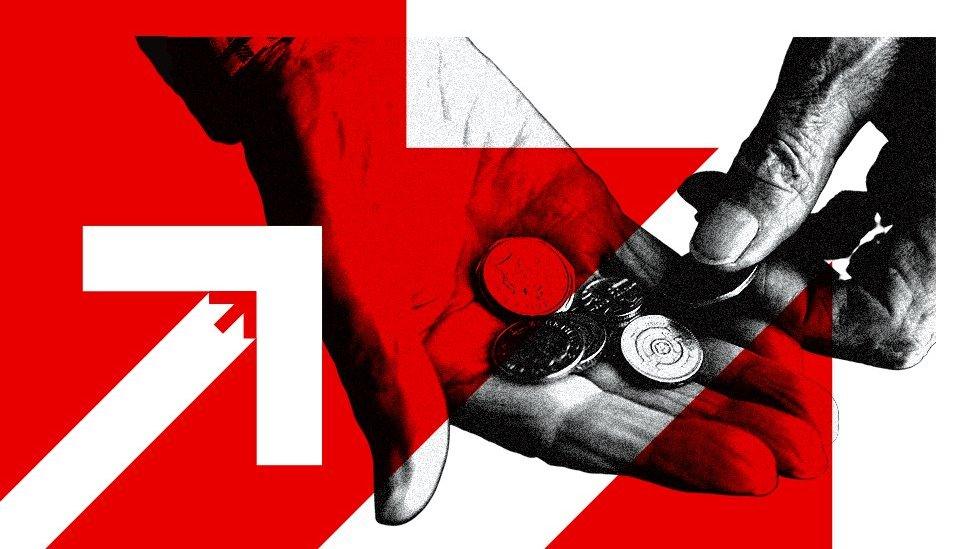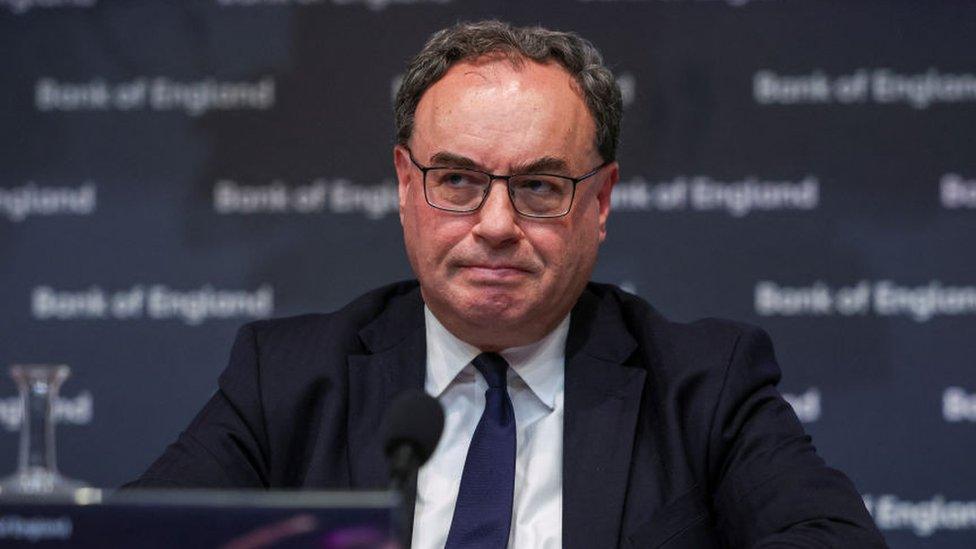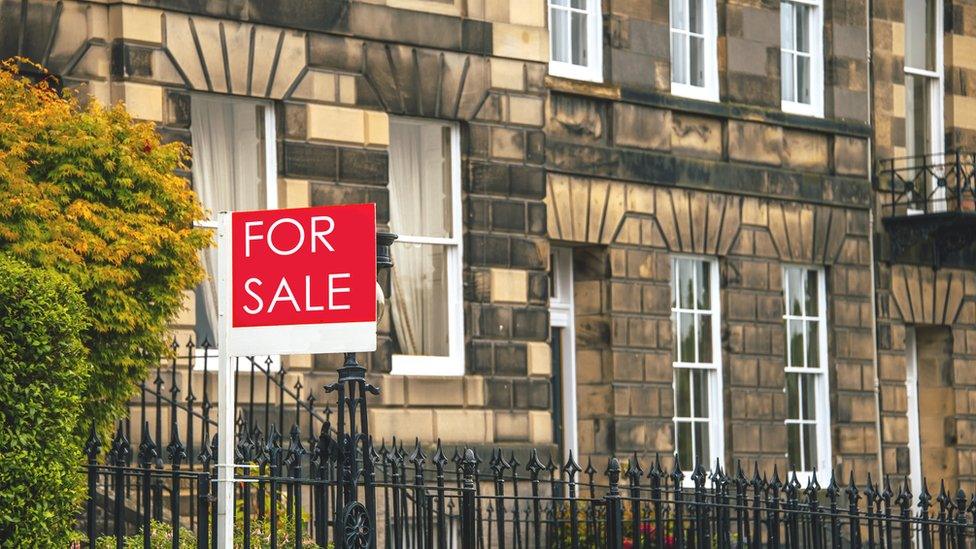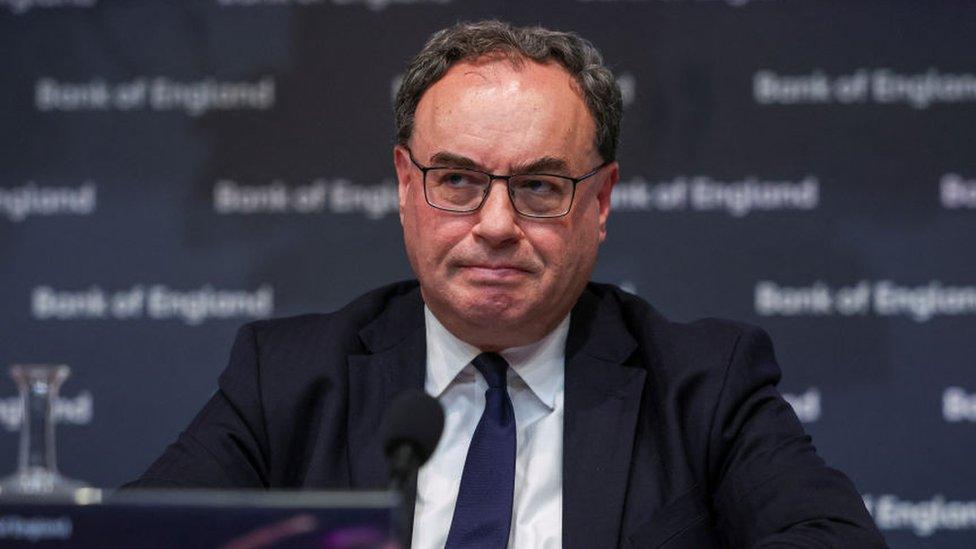Price inflation: Lumpy and sticky
- Published

Higher interest rates fall unevenly, tending to hit many of those with the tightest finances. That may go for parts of the UK as well as younger people.
One solution could be tackling inflation with higher tax, aimed at those best able to pay it.
Scottish firms have been found to have more of a problem with rising input costs as well as passing on their costs with higher prices. They are showing more positive signs than most parts of the UK, but without as much confidence about the next 12 months.
Harsh medicine for inflation does not have the same effect everywhere. Those who depend most on borrowing are those most affected by rising interest rates.
That can most affect those in the early years of home ownership - typically young families, at a time of life when finances are already stretched.
So the Bank of England's policy, fully supported by government and being reaffirmed by the central bank governor at a dinner on Monday - "it is crucial we see this job through" - is to put a chill on demand within the economy in the hope that it snuffs out inflation.
By international standards, that's not going well. The UK has higher price inflation than comparable large economies, and core inflation, excluding the more volatile and international effects of energy and food, is rising.
There are several reasons for that. Andrew Bailey's speech highlights the problem of unemployment. He doesn't say it in so many words, but the implication is clear, that unemployment simply isn't high enough to cause workers to moderate their wage demands.

Andrew Bailey says price inflation is "more sticky than previously expected"
Inflation is proving "sticky": "Both price and wage increases at current rates are not consistent with the inflation target".
This is also due to the structure of housing finance, which has changed in recent decades and means that the financial pain, which is an intended consequence of higher interest rates, takes longer to feed through to spending and investing behaviour.
In turn, that slow effect on inflation means interest rates going higher and staying there for longer than previously foreseen. Only with price stability, argues Andrew Bailey, can the UK economy thrive, and only then can people "trust that their hard-earned money maintains its value".
Those who do not depend on borrowed money are, obviously, less affected, and they are generally the more affluent households.
In response to that, one former member of the rate-setting Monetary Policy Committee at the Bank of England, suggested this weekend that monetary policy (interest rate rises) should be aligned with at least temporary tax increases designed to spread the pain a bit more evenly.
"We're asking monetary policy to do all the work," Kate Barker told the Financial Times. "We ought to be doing more of the work of driving out inflation by putting taxes up on the better-off." Specifically? "Income tax."
Backlogs of work
It may be that imbalance goes for parts of the UK as well. The latest snapshot of the private sector across the nations and regions points to markedly different performance of the economy around the UK.
The Purchasing Managers Index tells us the balance of how companies are getting on, when asked about a range of indicators: output, orders, backlogs of work, exports, recruitment and so on.
For June, Scotland comes out of it relatively well. Output was rising in the May figures, but it is now rising more strongly.
That puts it behind only London and south-east England in this measure of output, and a long way adrift from the negative figures for the south-west, East Midlands, north-east England and especially Wales.

New orders tell a similar story, according to these figures from Royal Bank of Scotland and NatWest, with Scotland second only to London.
Yet, confidence about the future does not reflect that: it's been slipping in most parts of the UK, and Scottish firms last month had relatively low levels of confidence about growth over the next 12 months. Only Northern Ireland and north-east England were more downbeat.
The issue that's been causing most concern across business, as with the government and Bank of England, has been rising prices. Input costs continue to rise for the vast majority of firms in this regular and wide-ranging survey, but that increase seems to be easing. However, it's a mixed picture. Scotland is behind only London in companies' perception of rising input costs.
The prices then charged to customers are also still on the rise. That rate of increase has also been easing, but last month remained greater in Scotland than any nation or region other than London, the south-east and the north-east of England.
Northern Ireland was found to have the least problem with rising input costs, and was passing on costs to customers at the lowest rate. That might have something to do with its increased integration into the European economy through seamless trade across the border with Ireland, while Brexit effects on the labour market and trade frictions contribute to a range of inflationary pressures on the British mainland.
House prices go red
These figures provide only one month's snapshot. They offer the balance of business opinion, rather than gauging how bad or good it looks on either side of the balance.
The ordering of nations and regions can change. All of them face difficulties with price inflation, the tight labour market and economic uncertainty.
But it offers some indication of the effect of economic policy being seen least in those parts of the country that are already relatively well off.

Most recent measures suggest Scotland's income per head trails only London, the south-east and east of England. Its property market is not given to the same volatility as England's and especially London's, so the impact of interest rates on house prices is more subdued.
The Halifax house price index, published on Friday, shows UK average house prices falling by 2.6% in the year to June - the third month of seeing that annual comparison going negative.
Scotland's house prices went into the red for the first time in three years, but with a reduction of only 0.1% over the year.
That's nowhere near enough of a fall for many of those with rising rents who would like to get on the housing ladder. But it continues both to reflect and to drive confidence about the economy more widely.
- Published10 July 2023

- Published22 June 2023

- Published13 June 2023

